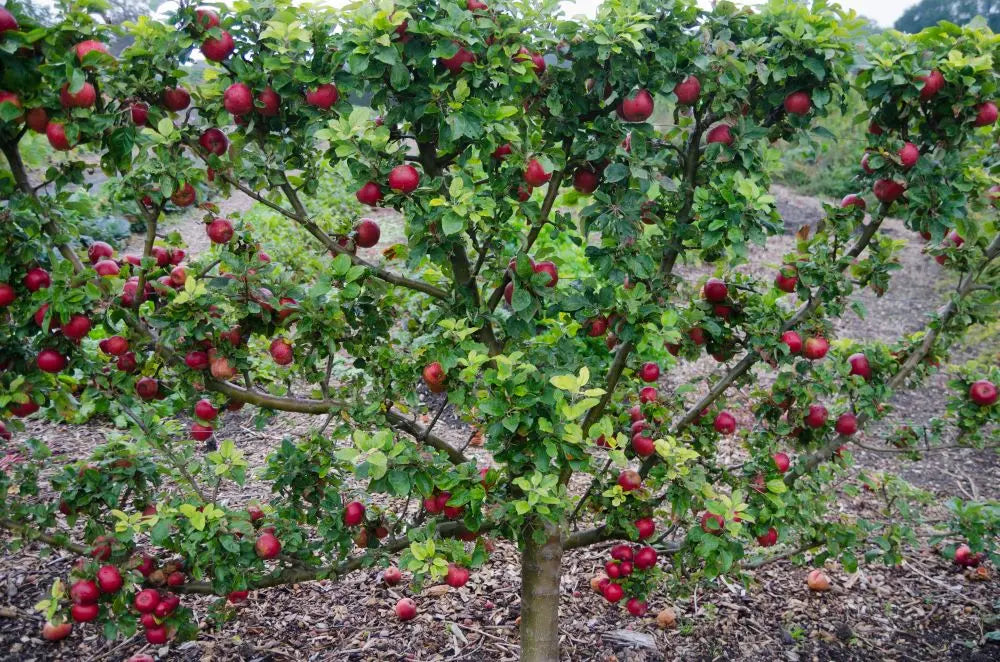From £6.99

Creating Your Own Fan-Trained Fruit Tree: A Guide
Creating Your Own Fan-Trained Fruit Tree: A Guide
Intro
Fan-trained fruit trees, also known as espalier fruit trees, are a beautiful and space-saving way to grow fruit in your garden. By training the branches of a tree to grow flat against a wall or fence, you can create a stunning and productive feature that will provide you with a bountiful harvest for years to come. In this guide, we will walk you through the process of creating your own fan-trained fruit tree, from choosing the right tree to harvesting the fruits of your labour.
Understanding Fan-Trained Fruit Trees
Fan-trained fruit trees embody a horticultural practice steeped in history, offering a fusion of aesthetic allure and practicality in fruit cultivation. This method involves meticulously directing the growth of a tree's branches against a flat plane, such as a wall or trellis, arranging them into a 'fan' shape. This not only maximises the use of limited space but also enhances the tree's exposure to sunlight, crucial for the development of fruit.
The art of espalier, under which fan training falls, is more than just a gardening technique; it's a way to transform an ordinary fruit tree into a living sculpture that beautifies the garden landscape. Moreover, the strategic arrangement simplifies tasks such as pruning, spraying, and harvesting, making it an advantageous approach for gardeners who wish to manage their trees with ease.
Embracing this method can dramatically increase the efficiency of light absorption by the leaves, thereby boosting photosynthesis and potentially leading to a more fruitful yield. The technique is applicable to a variety of fruit trees, with each species and variety presenting its own unique set of challenges and rewards. As such, fan training not only caters to the aesthetic and spatial needs of the modern gardener but also aligns with the practical requirements of fruit production.
Choosing the Right Tree for Fan Training
When embarking on the journey of cultivating a fan-trained fruit tree, selecting the appropriate species that thrives in your local climate and soil conditions is paramount. Fruit trees that are traditionally favoured for fan training encompass apple, pear, and cherry varieties due to their inherent adaptability and responsiveness to training. Nonetheless, the realm of possibilities extends beyond these common choices, inviting gardeners to explore other fruit-bearing trees for this purpose.
It's imperative to select a young tree, ideally one to two years old, as its branches are more pliable and conducive to shaping into the fan configuration. A specimen with a robust central leader and several well-spaced lateral branches is ideal, as these characteristics provide a solid foundation for training. Furthermore, consider the rootstock of the tree, as it directly influences the ultimate size of the tree – a critical factor when space is at a premium.
The success of a fan-trained fruit tree is significantly influenced by the initial selection process. Hence, taking the time to choose a tree that not only suits your aesthetic and spatial requirements but is also compatible with your region's environmental conditions, will lay the groundwork for a rewarding fan-training experience.
Initial Preparation and Planting
Before commencing the training of your tree, the site must be thoroughly prepared. Identifying a location that benefits from ample sunlight and possesses well-draining soil is essential for the flourishing of your tree. Erect a durable support structure, such as a trellis or a robust wire framework, against a wall or fence. This will serve as the backbone against which the tree will be trained. The structure should be installed before planting to avoid disturbing the tree's roots later on.
Planting should adhere to the nursery's guidelines, taking care to position the tree at the correct depth in the soil and ensuring that it is well-watered to facilitate initial establishment. If staking is necessary, ensure it does not interfere with the eventual spreading of the branches but provides enough support to keep the young tree upright and secure against strong winds. Early care is crucial; a mulch layer can be added around the base to retain moisture and suppress weeds, but keep it clear from the trunk to prevent rot.
The successful establishment of your fan-trained fruit tree hinges on these preparatory steps, laying a solid foundation for the shaping and training process that follows.
Training and Shaping Your Tree
The journey of moulding your fan-trained fruit tree begins earnestly once the tree has acclimatised to its new environment. The initial steps involve singling out the most viable branches, which will serve as the scaffold for the fan shape. These branches should exhibit both strength and flexibility, qualities essential for the bending process. Utilising soft ties or garden clips, carefully manipulate these chosen branches, guiding them gently towards the desired angles. It’s imperative to proceed with caution, avoiding any undue force that might result in breakage or harm to the plant.
As your tree matures, constant vigilance is necessary to guide its growth in accordance with the fan design. This includes attaching new growth to the support structure, ensuring branches spread out evenly and maintain the fan shape. Pruning plays a pivotal role in this phase, trimming back any unruly growth and removing branches that detract from the fan silhouette or overcrowd the structure. This not only preserves the aesthetic appeal but also encourages the tree to direct its energy towards fruit production.
During this formative period, patience is key. The tree will require time to adapt and conform to its new shape, a process that is as rewarding as it is gradual. By meticulously attending to the needs of your tree and gently steering its growth, you lay the foundation for a striking and fruitful fan-trained specimen.
Year-Round Care for Your Fan-Trained Tree
To ensure your fan-trained fruit tree remains healthy and continues to thrive, regular maintenance is essential throughout the year. Ensure consistent watering, particularly in periods of drought, to keep the soil adequately moist. In spring, enrich the tree with a balanced fertiliser to support vigorous growth and fruit development. Winter is the ideal time for pruning; this vital task involves removing any dead or damaged wood and thinning out branches that are too close together, which enhances air flow and facilitates better fruit set. Vigilance against pests and diseases is crucial; monitor your tree for any signs of distress and address issues promptly with suitable treatments. By adhering to these care practices, you'll help your tree sustain its vitality and productivity, ensuring a generous yield season after season.
Troubleshooting Common Problems
Despite meticulous care and attention, fan-trained fruit trees may sometimes face challenges that can hinder their growth and fruit production. It's vital to stay vigilant and act swiftly at the first sign of any issue to mitigate potential damage.
One common problem is pest infestation. Aphids, spider mites, and scale insects are frequent culprits that can be managed through natural predators, such as ladybirds, or by applying horticultural oils which suffocate the pests without harming the tree. Another issue is fungal diseases, including powdery mildew and fruit tree canker, which thrive in damp conditions. Ensuring good air circulation by appropriate pruning and applying fungicides as a preventative measure during the dormant season can help keep these diseases at bay.
Poor fruit set can also be concerning, often resulting from inadequate pollination or unfavourable weather conditions during flowering. To encourage better fruit set, consider planting companion pollinators if your tree variety requires cross-pollination, or gently hand-pollinate flowers using a soft brush.
Lastly, nutrient deficiencies can manifest as discolouration of leaves or stunted growth. Conducting a soil test can identify specific nutrient shortfalls, allowing you to address them with targeted fertilisation.
Acting on these issues promptly can help preserve the health and productivity of your fan-trained fruit tree, ensuring it remains a vibrant and fruitful feature in your garden.
Harvesting and Enjoying the Fruits of Your Labour
The culmination of your dedication and meticulous care of your fan-trained fruit tree is the delightful period of harvest. This is when the tree, having been attentively nurtured, offers up its bounty. The key to savouring the best flavours from your fruits is to harvest them when they've reached optimum ripeness. Unlike fruits that might be purchased from a shop, those grown in your own garden can be picked at the perfect moment, ensuring maximum sweetness and juiciness.
Tending to a fan-trained tree throughout the year lays the groundwork for this rewarding harvest. The unique structure of the tree not only makes the fruits more accessible but also tends to result in a higher quality of fruit, thanks to the improved air circulation and sunlight exposure afforded by the fan shape. When harvesting, be gentle to avoid bruising the fruit or damaging the branches, which could impact future yields.
Once picked, the fruits are ready to be relished in their natural state or transformed into delectable dishes. From fresh pies and tarts to jams and chutneys, the options for utilising your garden's produce are endless. Sharing these creations with family and friends can further enhance the joy of your harvest, making the fruits of your labour all the more satisfying.
It's important to continue with regular maintenance even after the harvest. This ensures that your fan-trained fruit tree remains healthy and productive, ready to provide you with another abundant crop in the seasons to come.
